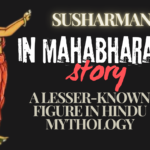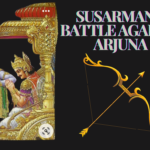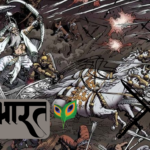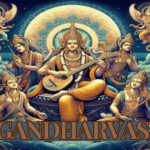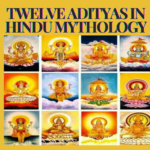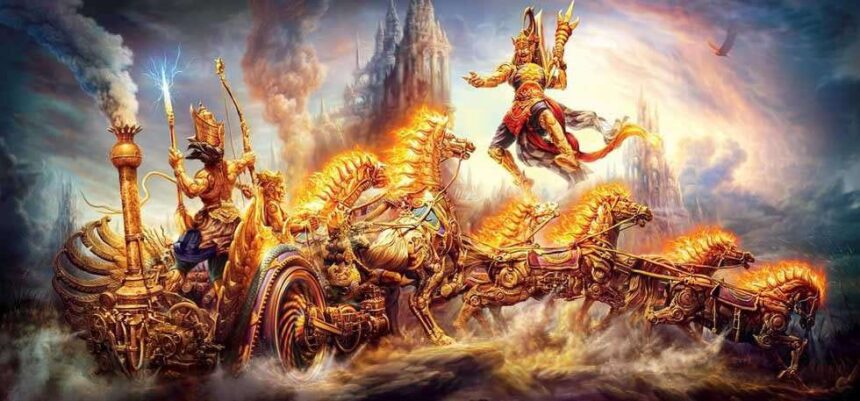In the rich tapestry of Hindu mythology, gods and goddesses are often depicted wielding weapons of immense power and symbolic significance. These weapons are not mere tools of war, but are imbued with deep meanings, representing cosmic principles, moral values, and divine authority. The legends associated with these weapons are as legendary as the gods themselves, each reflecting the complex beliefs and philosophies of ancient India.
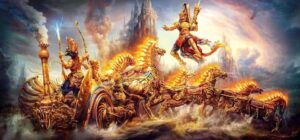
Tremendous power of Indra’s thunderbolt
One of the most revered weapons in Hindu mythology is the Vajra, the thunderbolt of Indra, the king of the gods. The vajra is described as an indestructible weapon that can destroy any opponent, symbolizing both strength and flexibility. Created by the divine architect Vishwakarma from the bones of the sage Dadhichi, the vajra represents the power of sacrifice for the greater good. It is believed to symbolize the power of a thousand thunderbolts, capable of wreaking unparalleled destruction on evil forces and is also a symbol of unbreakable spiritual strength and protection.

Indra’s use of the vajra in mythical battles underscores the idea that true power lies not in mere physical strength but in the courage to defend righteousness. The significance of the vajra goes far beyond its destructive capabilities; it is also a metaphor for the invincible power of truth and the inevitable triumph of good over evil.
Why does Indra have 1000 eyes?
As per the Brahma Vaivarta Purana, Gautama curses Indra to bear 1,000 vulvae, which will go to eyes when he venerates the sun-god Surya. Ahalya is gone to stone for 60,000 years and bound to be recovered simply by Rama’s touch. Ahalya acknowledges the decision without banter.
Vishnu’s eternal wheel of Sudarshan Chakra
Another famous weapon is the Sudarshan Chakra, the chakra of Vishnu, the protector of the universe. This spinning disc, with its razor-sharp edges, is a divine weapon that represents the cyclical nature of time and the endless pursuit of dharma (righteousness). The Sudarshan Chakra is often depicted as a symbol of cosmic order, reflecting the idea that all actions and events are part of a grand, eternal cycle.

Vishnu’s mastery over the Sudarshana Chakra reflects his role as the protector and sustainer of the universe, using the disc to vanquish demonic forces and restore balance. The chakra’s ability to return to Vishnu after being thrown symbolizes the concept of karma, where actions return to their source, emphasizing the importance of righteous conduct and the inevitable consequences of one’s deeds.
Who gave Krishna the Sudarshan Chakra?
As indicated by the Mahabharata, Krishna and Arjuna were asked by the shoot god Agni to assist him with opposing Indra; and since they had no weapons, he gave Arjuna the bow called Gandiva, and to Krishna he gave the Sudarshana Chakra, the plate with 108 serrated edges that had a place with Vishnu (whose symbol Krishna was).
Shiva’s Trishul: The Three-Pronged Spear of Destruction and Creation
Shiva, the destroyer in the Hindu trinity, uses the trishula, a three-pronged spear that holds deep symbolic meaning. Each prong of the Trishula represents the three fundamental aspects of existence: creation, preservation and destruction. This weapon is not only a tool of destruction but also a symbol of balance between these three forces, highlighting Shiva’s role as both destroyer and creator.

The symbolism of the trident extends to the three qualities of nature: sattva (purity), rajas (activity), and tamas (inertia). Shiva’s use of the trident in mythology signifies the necessity of destruction as a precursor to creation, reflecting the cyclical nature of life and the universe. The trident is thus a reminder that destruction is not simply an end but a necessary process for the renewal and continuation of life.
Who gave Trishul to Shiva?
The blasting energy slid towards the ground, utilized by Vishvakarma to make the trishula for Shiva, the Sudarshana Chakra for Vishnu, a cart for Kubera, the spear for Kartikeya, and the wide range of various weapons of the divine beings.
Rama’s Kodanda: Bow of Dharma
Rama, the seventh incarnation of Vishnu and hero of the epic Ramayana, is closely associated with his bow, Kodanda. It symbolizes dharma, duty, and moral integrity. It symbolizes righteousness, duty, and moral integrity. Throughout the Ramayana, Rama’s use of the Kodanda signifies his unwavering commitment to dharma, as he uses the bow to protect the innocent and uphold justice.

The Kodanda represents the warrior’s duty to fight to protect dharma, even when faced with great personal challenges. Rama’s victory with this bow highlights the importance of following one’s moral responsibilities, despite difficulties. Therefore, Kodanda stands as a testimony to the power of righteousness and the ultimate victory of good over evil.
What is the difference between Rama and Kodanda Rama?
There is no difference. Actually Kodanda means the bow he holds in his hands, and we always see him with Kodanda in hand in all our temples or in pictures. A bhakt call him in this particular name “Kodanda Rama” when he requesting the protection from him.
Kartikeya’s Vel: The Spear of Divine Victory
Kartikeya, the god of war and son of Shiva and Parvati, holds the Vel, a divine spear that symbolizes victory over evil and the pursuit of knowledge. The Vel represents Kartikeya’s role as a warrior god, signifying the qualities of bravery, strength, and divine wisdom. The Vel is believed to have been gifted to Kartikeya by his mother Parvati to defeat the demon Surapadman, signifying the power of divine support in the battle against darkness.

The Vel’s sharpness and precision are metaphors for the piercing power of truth and knowledge, which can overcome ignorance and evil. In many depictions, Kartikeya is shown victoriously holding the Vel, symbolizing his victory over the forces of chaos and his role as the protector of the righteous.
Where did Kartikeya get his Vel?
As per Shaiva custom, the goddess Parvati introduced the Vel to her child Kartikeya, as an encapsulation of her shakti, to vanquish the asura Surapadman. As per the Skanda Purana, in the conflict among Kartikeya and Surapadman, Kartikeya utilized the vel to overcome every one of the powers of Surapadman.
Brahmāstra: The Weapon of the End of Creation
The Brahmastra is another formidable weapon in Hindu mythology, often associated with the creator god Brahma. The Brahmastra is considered one of the most powerful weapons ever created, with the potential to destroy the entire world. It is said that when it is invoked, it explodes as bright as thousands of suns, reducing everything in its path to ashes.

The Brahmastra was used by many prominent figures in the Hindu epics, including Rama, who used it to kill the demon king Ravana in the Ramayana. In the Mahabharata, both Arjuna and Ashwatthama are depicted as wielders of this divine weapon, but extreme caution is exercised in its use due to its catastrophic effects.
Vishnu’s Sword of Wisdom
The Nandaka is the sword wielded by Lord Vishnu, one of the major deities in Hinduism. Unlike many other weapons that symbolize raw power, the Nandaka represents knowledge and wisdom. Vishnu uses the Nandaka to destroy ignorance and protect Dharma, emphasizing the importance of knowledge as a weapon against chaos and evil.

In various depictions, Nandaka is shown alongside other iconic weapons of Vishnu, such as the Sudarshana Chakra, which emphasizes the complementary roles of knowledge and righteous action. The sword is not just a tool of war but also a symbol of dispelling illusions and misunderstandings, which are seen as the root cause of suffering.
The Axe of Lord Parashurama
The sixth incarnation of Vishnu, Parashurama, is known for wielding Parashu, a divine axe given to him by Lord Shiva. Parashurama’s name itself means “Rama with an axe” and his weapon is a symbol of divine retribution. Parashu is associated with the destruction of corrupt and tyrannical rulers who fail to uphold dharma.

Who blessed Parasurama with an axe?
Parasurama was the son of the pious saint, Jamadagni. Lord Shiva, pleased by his devotion and penance awarded him an axe, his super weapon. Parashurama is considered ‘Chiranjeevi’ or immortal and that he is said to rule until ‘Maha Pralaya’ or the end of the world.
The deeper meanings behind these mythological weapons
Each of these weapons is much more than a tool of war; they are symbols of deep philosophical concepts and moral values. Indra’s vajra teaches us about the strength that comes from sacrifice and the power of truth. Vishnu’s Sudarshana Chakra reminds us of the cyclical nature of time and the importance of maintaining cosmic order. Shiva’s Trishul symbolizes the delicate balance between creation and destruction, while Rama’s Kodanda and Kartikeya’s Vel emphasize the importance of the pursuit of righteousness and wisdom in the face of evil.
These weapons, and the deities who wield them, provide profound insight into the values and beliefs that have shaped Hindu culture and spirituality over the millennia. By understanding the symbolism of these divine weapons, we gain a deeper appreciation of the timeless lessons contained in Hindu mythology, lessons that continue to resonate in the modern world.
